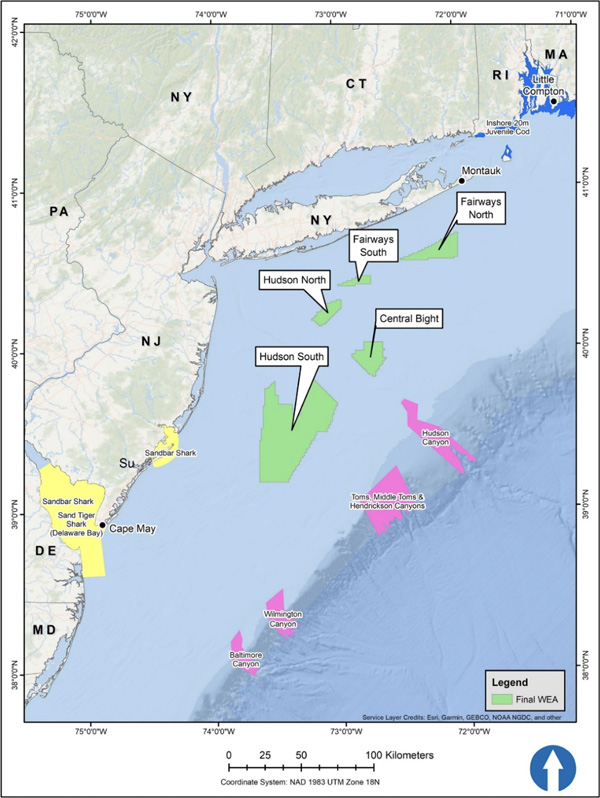
Advocacy organizations and some coastal residents asked the U.S. Bureau of Ocean Energy Management to pause before selling new offshore wind leases in the New York Bight, the ocean area between Long Island and Cape May, N.J., while others urged the agency to move forward without delay.
BOEM held two public hearings Aug. 25 and 26 before the comment submission deadline of Sept. 9, hearing the various opinions as well as requests to extend the 30-day public comment period on a draft environmental assessment (EA) of new offshore wind leases in the bight (BOEM-2021-0054). (See BOEM Preps New Wind Leases off NYC.)
“We are requesting an extension to the comment period and an additional public hearing due to the scope and magnitude of the proposal,” said Cindy Zipf, executive director of Clean Ocean Action, a coalition of groups that work on the waters between Cape May and Montauk, N.Y. “Wouldn’t it be best to learn from some of the experience from New Jersey’s 425,000 acres than to rush ahead with 800,000 acres? This is especially true since we have so little understanding of the development, construction and experience with that, and so little science to avoid, reduce or fix any harm done.”
BOEM should not reduce the size of the lease areas, nor delay the pre-construction process, unless a substantial negative environmental impact is identified, said Caroline Hahn of the New York League of Conservation Voters.
“These areas have already gone through a significant review process to avoid user conflicts, and these areas are crucial to achieve our renewable energy goals,” Hahn said.
Recreational anglers support the development of offshore wind both because they see firsthand how climate change is impacting fisheries, and also because the turbine foundations act as artificial reefs that attract many species of fish, said Paul Eidman of Anglers for Offshore Wind Power. “I would ask BOEM to move forward with this process because as a recreational fishing angler and a recreational fishing guide … I am excited about all the opportunities that offshore wind has to offer us.”
When people see only little bits and pieces of a huge industrialization effort, they cannot see what is really going on or going to happen, said Delaware resident Amy Kyle, a recently retired environmental health scientist from the faculty of the University of California, Berkeley.

Ørsted US Offshore Wind’s 1,100-MW Ocean Wind I and 1,148-MW Ocean Wind II projects “got to be four times taller, and recently has gotten four times bigger, all after the initial assessments were done,” Kyle said.
“I cannot see any venue where anybody is seriously looking at the combined impact of all of these activities on the system as a whole, and also the regional-scale resources, which for us include marine mammals and also birds,” Kyle said. “I don’t see where we are looking at the puzzle as a whole … [which] is a tremendous scientific deficit here [that] should not be allowed to just go on.”
It is “impossible to comprehend” that BOEM would entertain subjecting an additional 800,000 acres of ocean waters marine habitat and bird migration flyway for a test case, Jersey Shore resident Lynn Schambach said.
“Many marines scientists agree that little is known about the harm from this industrialization of the ocean, especially at the magnitude, scale and speed of development currently proposed,” Schambach said.
What’s the rush? asked Paul Kanitra, mayor of Point Pleasant Beach, N.J.
“You’ve been relying on stealth and speed to get this done, and that’s scary. Government is trying to disguise huge greedy corporations who answer only to stakeholders as some sort of cute homespun green initiative,” Kanitra said.
Corporations “could not care less” about what impact they leave, and the wind farms will be irreversible, he said. The turbine blades aren’t recyclable and are the size of 18-wheelers. The salt air destroys the structures within only 20 years and then more money needs to be spent to hopefully cart them away or leave them resting on the horizon, he said.
For those who say just pause and delay, the U.S. has been doing so for decades, said Adrienne Esposito, executive director of Citizens Campaign for the Environment, a New York organization with 140,000 members.
“Most marine scientists are not fretting about the little-understood impacts of offshore wind, but rather are intensely concerned about the impacts of climate change,” Esposito said. “Marine scientists agree that the changing currents, acidification of our oceans and sea level rise are all impacting marine species, particularly benthic-dwelling organisms.”

